HC1021 - Social Media's Impact on Business Communication Today
VerifiedAdded on 2023/06/13
|8
|2821
|114
Essay
AI Summary
This essay examines the profound impact of social media on contemporary business communication, detailing how it has reshaped business operations in the modern era. It explores both the opportunities and challenges that social media presents, such as enhanced customer engagement, reduced marketing costs, and global audience reach, alongside risks like reputation damage from negative reviews and privacy concerns. The essay references various studies and real-world examples, including the BlackBerry case, to illustrate the double-edged nature of social media in business. It also discusses the rise of organic marketing and the importance of brand transparency in the age of social media. The essay concludes that businesses must embrace social media strategically while remaining vigilant about its potential pitfalls to thrive in today's interconnected world. Desklib provides a platform for students to access this essay and many more resources for their academic needs.
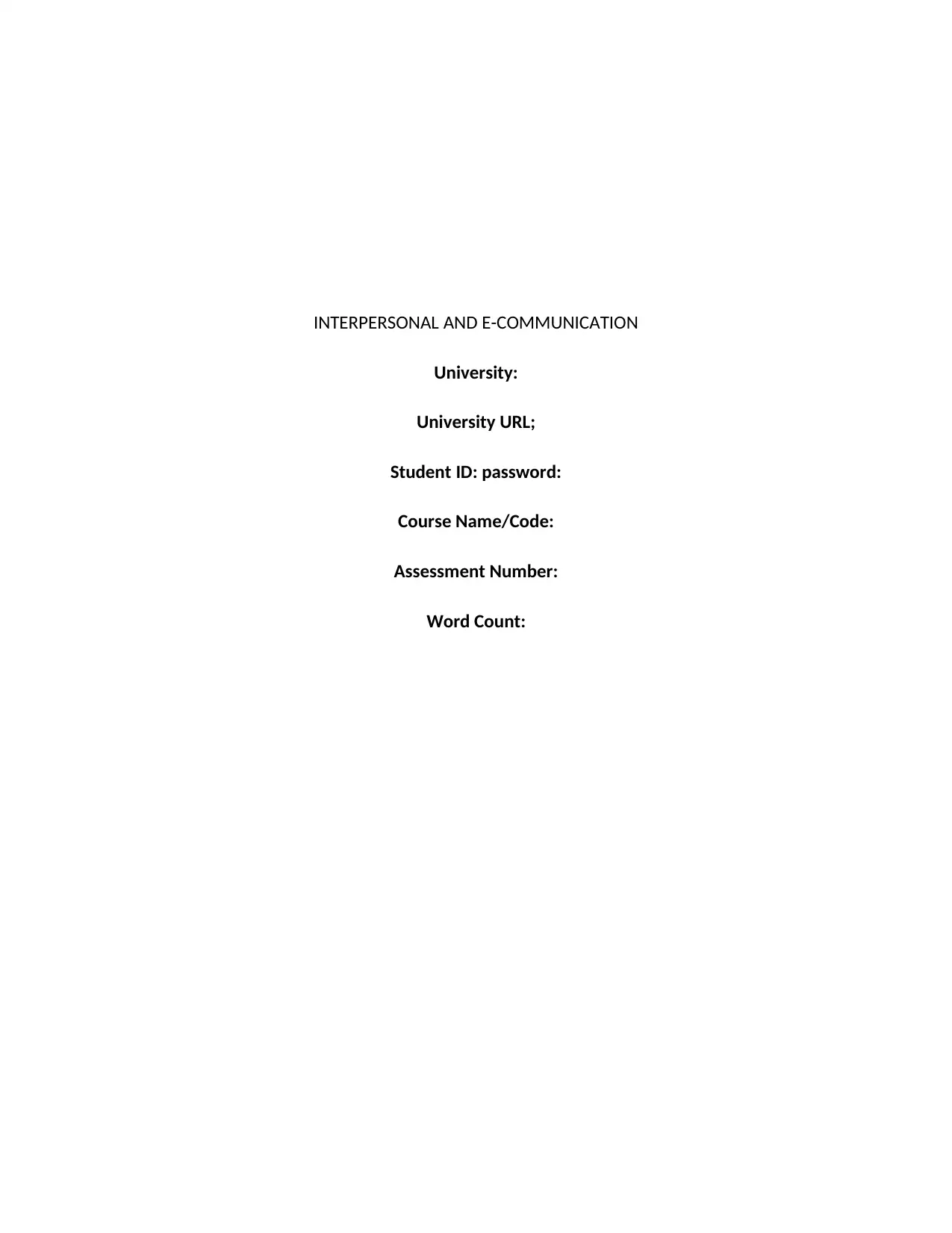
INTERPERSONAL AND E-COMMUNICATION
University:
University URL;
Student ID: password:
Course Name/Code:
Assessment Number:
Word Count:
University:
University URL;
Student ID: password:
Course Name/Code:
Assessment Number:
Word Count:
Paraphrase This Document
Need a fresh take? Get an instant paraphrase of this document with our AI Paraphraser
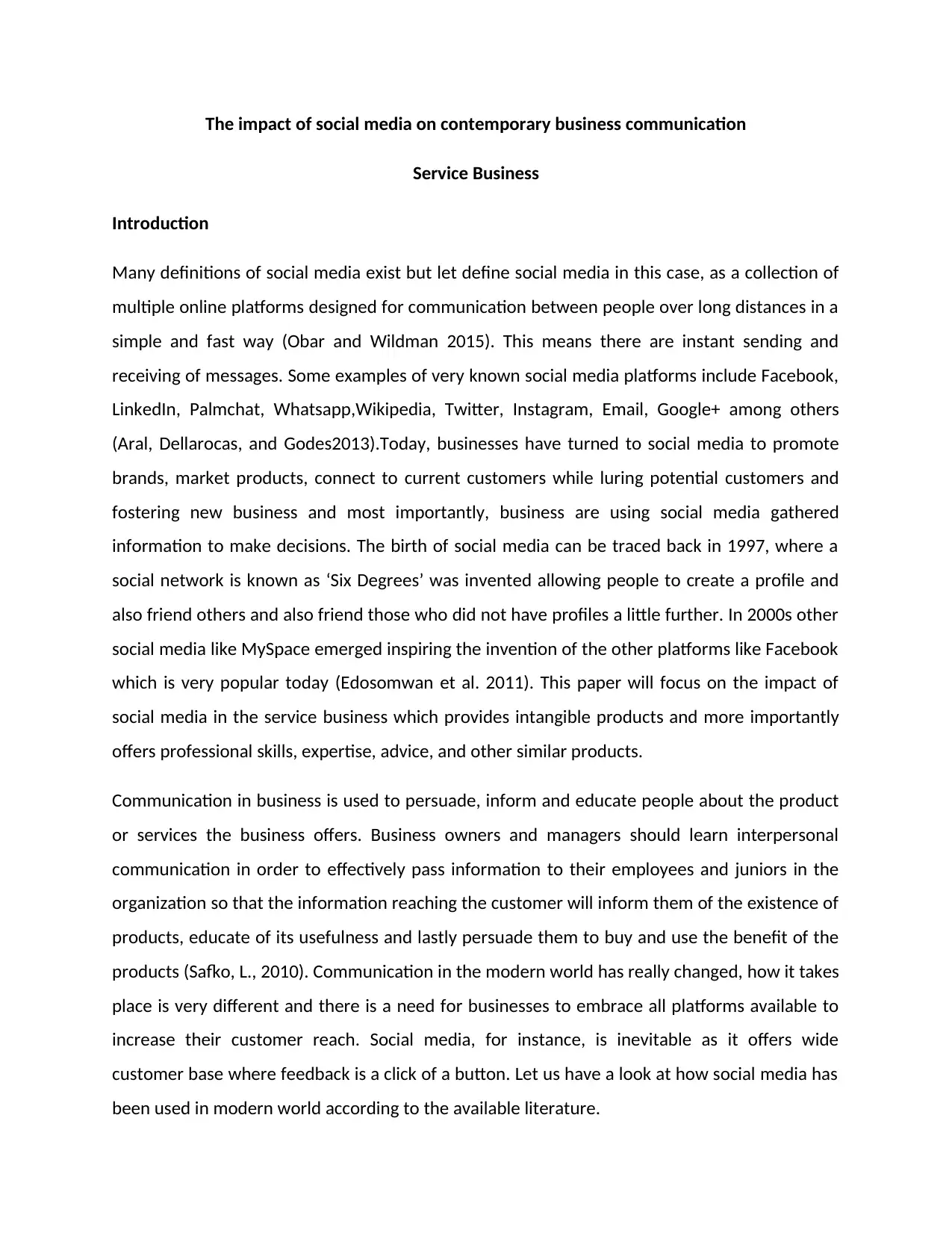
The impact of social media on contemporary business communication
Service Business
Introduction
Many definitions of social media exist but let define social media in this case, as a collection of
multiple online platforms designed for communication between people over long distances in a
simple and fast way (Obar and Wildman 2015). This means there are instant sending and
receiving of messages. Some examples of very known social media platforms include Facebook,
LinkedIn, Palmchat, Whatsapp,Wikipedia, Twitter, Instagram, Email, Google+ among others
(Aral, Dellarocas, and Godes2013).Today, businesses have turned to social media to promote
brands, market products, connect to current customers while luring potential customers and
fostering new business and most importantly, business are using social media gathered
information to make decisions. The birth of social media can be traced back in 1997, where a
social network is known as ‘Six Degrees’ was invented allowing people to create a profile and
also friend others and also friend those who did not have profiles a little further. In 2000s other
social media like MySpace emerged inspiring the invention of the other platforms like Facebook
which is very popular today (Edosomwan et al. 2011). This paper will focus on the impact of
social media in the service business which provides intangible products and more importantly
offers professional skills, expertise, advice, and other similar products.
Communication in business is used to persuade, inform and educate people about the product
or services the business offers. Business owners and managers should learn interpersonal
communication in order to effectively pass information to their employees and juniors in the
organization so that the information reaching the customer will inform them of the existence of
products, educate of its usefulness and lastly persuade them to buy and use the benefit of the
products (Safko, L., 2010). Communication in the modern world has really changed, how it takes
place is very different and there is a need for businesses to embrace all platforms available to
increase their customer reach. Social media, for instance, is inevitable as it offers wide
customer base where feedback is a click of a button. Let us have a look at how social media has
been used in modern world according to the available literature.
Service Business
Introduction
Many definitions of social media exist but let define social media in this case, as a collection of
multiple online platforms designed for communication between people over long distances in a
simple and fast way (Obar and Wildman 2015). This means there are instant sending and
receiving of messages. Some examples of very known social media platforms include Facebook,
LinkedIn, Palmchat, Whatsapp,Wikipedia, Twitter, Instagram, Email, Google+ among others
(Aral, Dellarocas, and Godes2013).Today, businesses have turned to social media to promote
brands, market products, connect to current customers while luring potential customers and
fostering new business and most importantly, business are using social media gathered
information to make decisions. The birth of social media can be traced back in 1997, where a
social network is known as ‘Six Degrees’ was invented allowing people to create a profile and
also friend others and also friend those who did not have profiles a little further. In 2000s other
social media like MySpace emerged inspiring the invention of the other platforms like Facebook
which is very popular today (Edosomwan et al. 2011). This paper will focus on the impact of
social media in the service business which provides intangible products and more importantly
offers professional skills, expertise, advice, and other similar products.
Communication in business is used to persuade, inform and educate people about the product
or services the business offers. Business owners and managers should learn interpersonal
communication in order to effectively pass information to their employees and juniors in the
organization so that the information reaching the customer will inform them of the existence of
products, educate of its usefulness and lastly persuade them to buy and use the benefit of the
products (Safko, L., 2010). Communication in the modern world has really changed, how it takes
place is very different and there is a need for businesses to embrace all platforms available to
increase their customer reach. Social media, for instance, is inevitable as it offers wide
customer base where feedback is a click of a button. Let us have a look at how social media has
been used in modern world according to the available literature.
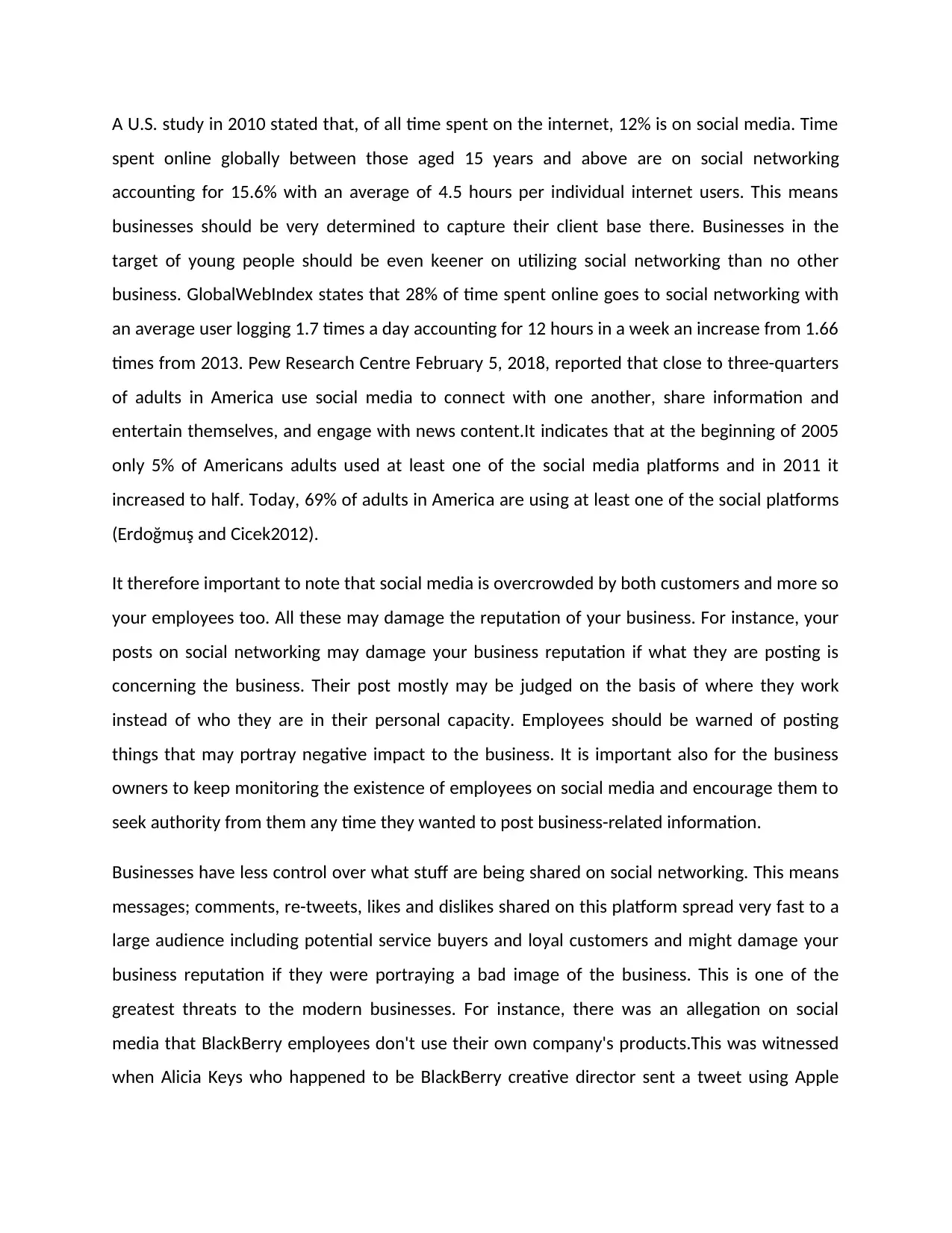
A U.S. study in 2010 stated that, of all time spent on the internet, 12% is on social media. Time
spent online globally between those aged 15 years and above are on social networking
accounting for 15.6% with an average of 4.5 hours per individual internet users. This means
businesses should be very determined to capture their client base there. Businesses in the
target of young people should be even keener on utilizing social networking than no other
business. GlobalWebIndex states that 28% of time spent online goes to social networking with
an average user logging 1.7 times a day accounting for 12 hours in a week an increase from 1.66
times from 2013. Pew Research Centre February 5, 2018, reported that close to three-quarters
of adults in America use social media to connect with one another, share information and
entertain themselves, and engage with news content.It indicates that at the beginning of 2005
only 5% of Americans adults used at least one of the social media platforms and in 2011 it
increased to half. Today, 69% of adults in America are using at least one of the social platforms
(Erdoğmuş and Cicek2012).
It therefore important to note that social media is overcrowded by both customers and more so
your employees too. All these may damage the reputation of your business. For instance, your
posts on social networking may damage your business reputation if what they are posting is
concerning the business. Their post mostly may be judged on the basis of where they work
instead of who they are in their personal capacity. Employees should be warned of posting
things that may portray negative impact to the business. It is important also for the business
owners to keep monitoring the existence of employees on social media and encourage them to
seek authority from them any time they wanted to post business-related information.
Businesses have less control over what stuff are being shared on social networking. This means
messages; comments, re-tweets, likes and dislikes shared on this platform spread very fast to a
large audience including potential service buyers and loyal customers and might damage your
business reputation if they were portraying a bad image of the business. This is one of the
greatest threats to the modern businesses. For instance, there was an allegation on social
media that BlackBerry employees don't use their own company's products.This was witnessed
when Alicia Keys who happened to be BlackBerry creative director sent a tweet using Apple
spent online globally between those aged 15 years and above are on social networking
accounting for 15.6% with an average of 4.5 hours per individual internet users. This means
businesses should be very determined to capture their client base there. Businesses in the
target of young people should be even keener on utilizing social networking than no other
business. GlobalWebIndex states that 28% of time spent online goes to social networking with
an average user logging 1.7 times a day accounting for 12 hours in a week an increase from 1.66
times from 2013. Pew Research Centre February 5, 2018, reported that close to three-quarters
of adults in America use social media to connect with one another, share information and
entertain themselves, and engage with news content.It indicates that at the beginning of 2005
only 5% of Americans adults used at least one of the social media platforms and in 2011 it
increased to half. Today, 69% of adults in America are using at least one of the social platforms
(Erdoğmuş and Cicek2012).
It therefore important to note that social media is overcrowded by both customers and more so
your employees too. All these may damage the reputation of your business. For instance, your
posts on social networking may damage your business reputation if what they are posting is
concerning the business. Their post mostly may be judged on the basis of where they work
instead of who they are in their personal capacity. Employees should be warned of posting
things that may portray negative impact to the business. It is important also for the business
owners to keep monitoring the existence of employees on social media and encourage them to
seek authority from them any time they wanted to post business-related information.
Businesses have less control over what stuff are being shared on social networking. This means
messages; comments, re-tweets, likes and dislikes shared on this platform spread very fast to a
large audience including potential service buyers and loyal customers and might damage your
business reputation if they were portraying a bad image of the business. This is one of the
greatest threats to the modern businesses. For instance, there was an allegation on social
media that BlackBerry employees don't use their own company's products.This was witnessed
when Alicia Keys who happened to be BlackBerry creative director sent a tweet using Apple
⊘ This is a preview!⊘
Do you want full access?
Subscribe today to unlock all pages.

Trusted by 1+ million students worldwide
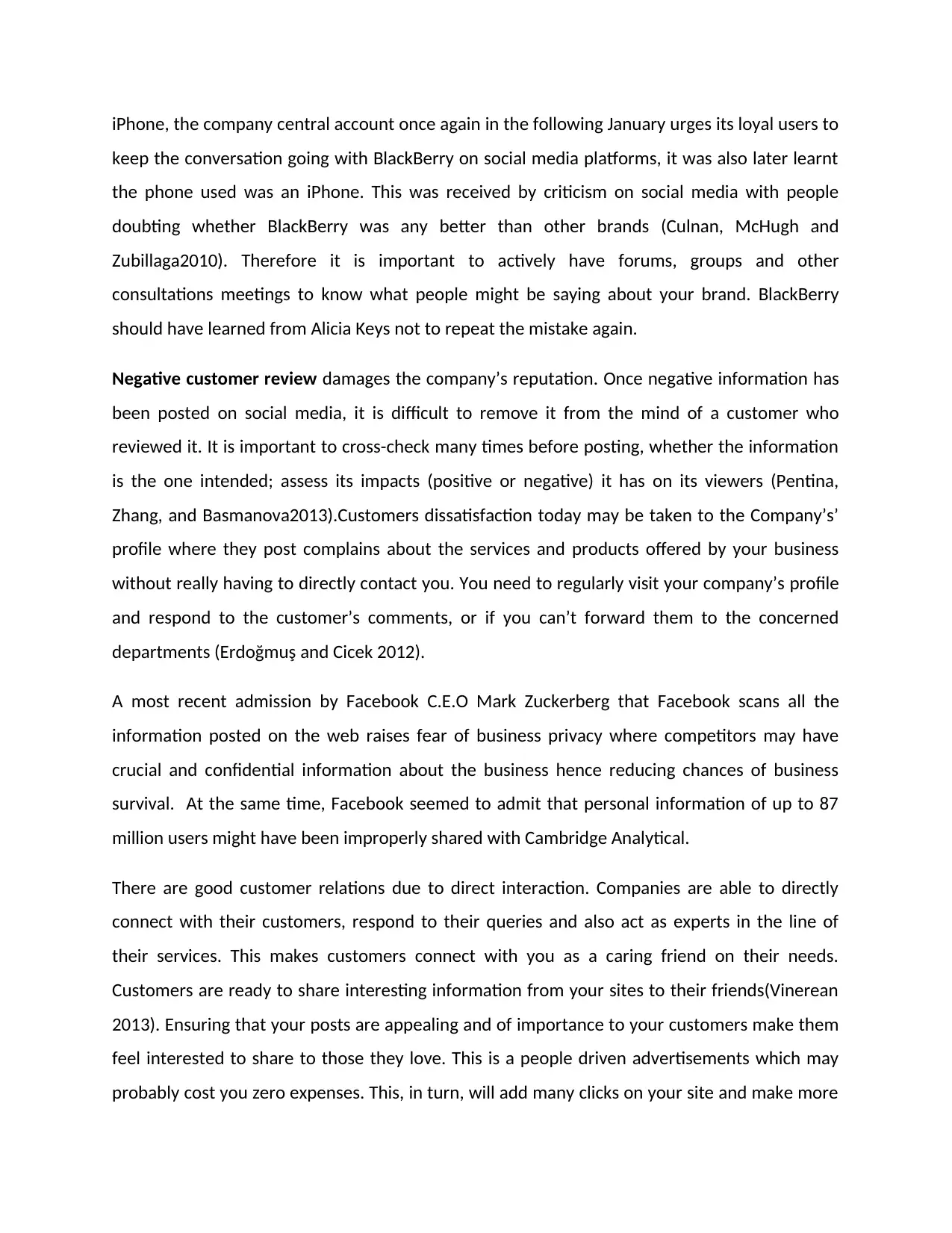
iPhone, the company central account once again in the following January urges its loyal users to
keep the conversation going with BlackBerry on social media platforms, it was also later learnt
the phone used was an iPhone. This was received by criticism on social media with people
doubting whether BlackBerry was any better than other brands (Culnan, McHugh and
Zubillaga2010). Therefore it is important to actively have forums, groups and other
consultations meetings to know what people might be saying about your brand. BlackBerry
should have learned from Alicia Keys not to repeat the mistake again.
Negative customer review damages the company’s reputation. Once negative information has
been posted on social media, it is difficult to remove it from the mind of a customer who
reviewed it. It is important to cross-check many times before posting, whether the information
is the one intended; assess its impacts (positive or negative) it has on its viewers (Pentina,
Zhang, and Basmanova2013).Customers dissatisfaction today may be taken to the Company’s’
profile where they post complains about the services and products offered by your business
without really having to directly contact you. You need to regularly visit your company’s profile
and respond to the customer’s comments, or if you can’t forward them to the concerned
departments (Erdoğmuş and Cicek 2012).
A most recent admission by Facebook C.E.O Mark Zuckerberg that Facebook scans all the
information posted on the web raises fear of business privacy where competitors may have
crucial and confidential information about the business hence reducing chances of business
survival. At the same time, Facebook seemed to admit that personal information of up to 87
million users might have been improperly shared with Cambridge Analytical.
There are good customer relations due to direct interaction. Companies are able to directly
connect with their customers, respond to their queries and also act as experts in the line of
their services. This makes customers connect with you as a caring friend on their needs.
Customers are ready to share interesting information from your sites to their friends(Vinerean
2013). Ensuring that your posts are appealing and of importance to your customers make them
feel interested to share to those they love. This is a people driven advertisements which may
probably cost you zero expenses. This, in turn, will add many clicks on your site and make more
keep the conversation going with BlackBerry on social media platforms, it was also later learnt
the phone used was an iPhone. This was received by criticism on social media with people
doubting whether BlackBerry was any better than other brands (Culnan, McHugh and
Zubillaga2010). Therefore it is important to actively have forums, groups and other
consultations meetings to know what people might be saying about your brand. BlackBerry
should have learned from Alicia Keys not to repeat the mistake again.
Negative customer review damages the company’s reputation. Once negative information has
been posted on social media, it is difficult to remove it from the mind of a customer who
reviewed it. It is important to cross-check many times before posting, whether the information
is the one intended; assess its impacts (positive or negative) it has on its viewers (Pentina,
Zhang, and Basmanova2013).Customers dissatisfaction today may be taken to the Company’s’
profile where they post complains about the services and products offered by your business
without really having to directly contact you. You need to regularly visit your company’s profile
and respond to the customer’s comments, or if you can’t forward them to the concerned
departments (Erdoğmuş and Cicek 2012).
A most recent admission by Facebook C.E.O Mark Zuckerberg that Facebook scans all the
information posted on the web raises fear of business privacy where competitors may have
crucial and confidential information about the business hence reducing chances of business
survival. At the same time, Facebook seemed to admit that personal information of up to 87
million users might have been improperly shared with Cambridge Analytical.
There are good customer relations due to direct interaction. Companies are able to directly
connect with their customers, respond to their queries and also act as experts in the line of
their services. This makes customers connect with you as a caring friend on their needs.
Customers are ready to share interesting information from your sites to their friends(Vinerean
2013). Ensuring that your posts are appealing and of importance to your customers make them
feel interested to share to those they love. This is a people driven advertisements which may
probably cost you zero expenses. This, in turn, will add many clicks on your site and make more
Paraphrase This Document
Need a fresh take? Get an instant paraphrase of this document with our AI Paraphraser
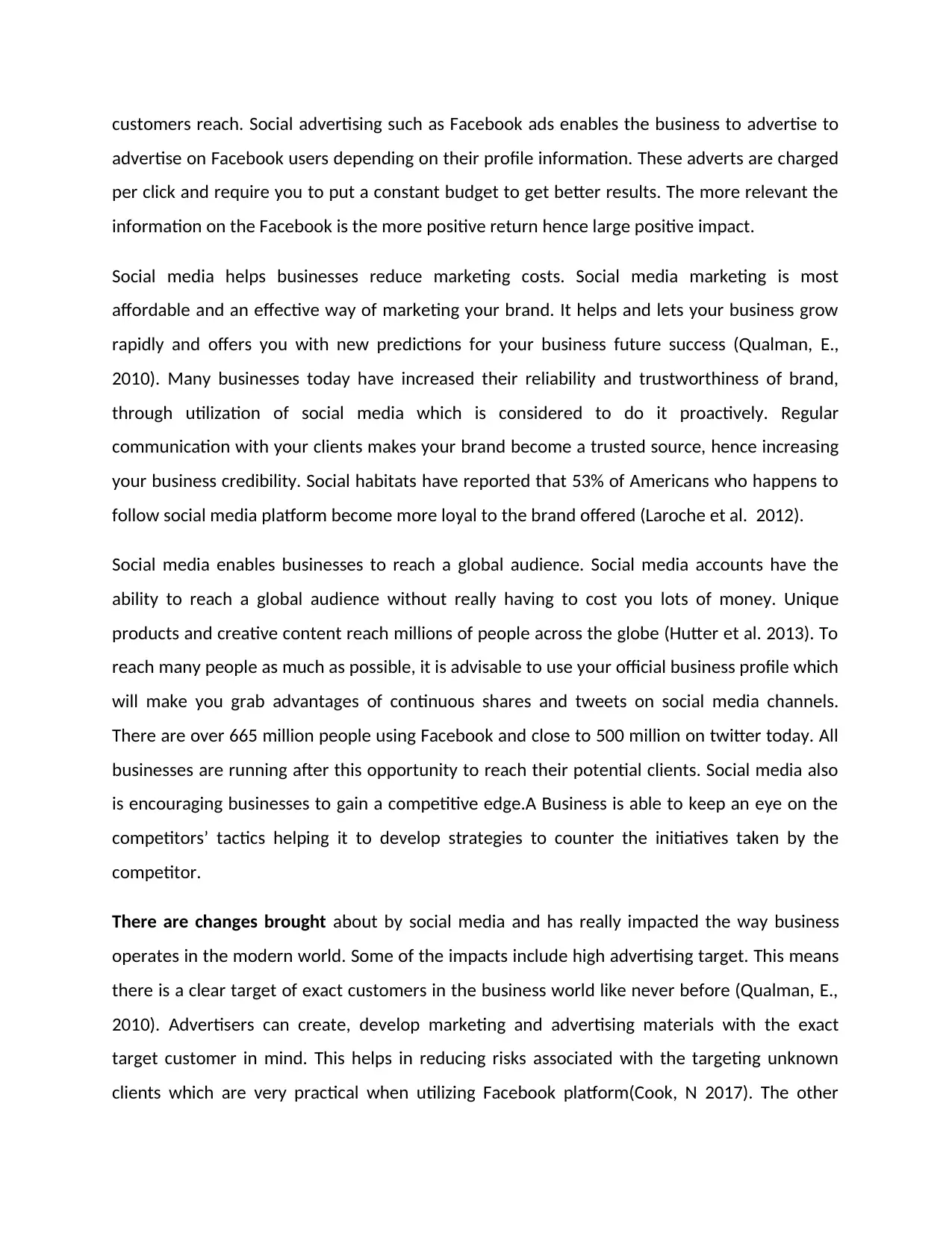
customers reach. Social advertising such as Facebook ads enables the business to advertise to
advertise on Facebook users depending on their profile information. These adverts are charged
per click and require you to put a constant budget to get better results. The more relevant the
information on the Facebook is the more positive return hence large positive impact.
Social media helps businesses reduce marketing costs. Social media marketing is most
affordable and an effective way of marketing your brand. It helps and lets your business grow
rapidly and offers you with new predictions for your business future success (Qualman, E.,
2010). Many businesses today have increased their reliability and trustworthiness of brand,
through utilization of social media which is considered to do it proactively. Regular
communication with your clients makes your brand become a trusted source, hence increasing
your business credibility. Social habitats have reported that 53% of Americans who happens to
follow social media platform become more loyal to the brand offered (Laroche et al. 2012).
Social media enables businesses to reach a global audience. Social media accounts have the
ability to reach a global audience without really having to cost you lots of money. Unique
products and creative content reach millions of people across the globe (Hutter et al. 2013). To
reach many people as much as possible, it is advisable to use your official business profile which
will make you grab advantages of continuous shares and tweets on social media channels.
There are over 665 million people using Facebook and close to 500 million on twitter today. All
businesses are running after this opportunity to reach their potential clients. Social media also
is encouraging businesses to gain a competitive edge.A Business is able to keep an eye on the
competitors’ tactics helping it to develop strategies to counter the initiatives taken by the
competitor.
There are changes brought about by social media and has really impacted the way business
operates in the modern world. Some of the impacts include high advertising target. This means
there is a clear target of exact customers in the business world like never before (Qualman, E.,
2010). Advertisers can create, develop marketing and advertising materials with the exact
target customer in mind. This helps in reducing risks associated with the targeting unknown
clients which are very practical when utilizing Facebook platform(Cook, N 2017). The other
advertise on Facebook users depending on their profile information. These adverts are charged
per click and require you to put a constant budget to get better results. The more relevant the
information on the Facebook is the more positive return hence large positive impact.
Social media helps businesses reduce marketing costs. Social media marketing is most
affordable and an effective way of marketing your brand. It helps and lets your business grow
rapidly and offers you with new predictions for your business future success (Qualman, E.,
2010). Many businesses today have increased their reliability and trustworthiness of brand,
through utilization of social media which is considered to do it proactively. Regular
communication with your clients makes your brand become a trusted source, hence increasing
your business credibility. Social habitats have reported that 53% of Americans who happens to
follow social media platform become more loyal to the brand offered (Laroche et al. 2012).
Social media enables businesses to reach a global audience. Social media accounts have the
ability to reach a global audience without really having to cost you lots of money. Unique
products and creative content reach millions of people across the globe (Hutter et al. 2013). To
reach many people as much as possible, it is advisable to use your official business profile which
will make you grab advantages of continuous shares and tweets on social media channels.
There are over 665 million people using Facebook and close to 500 million on twitter today. All
businesses are running after this opportunity to reach their potential clients. Social media also
is encouraging businesses to gain a competitive edge.A Business is able to keep an eye on the
competitors’ tactics helping it to develop strategies to counter the initiatives taken by the
competitor.
There are changes brought about by social media and has really impacted the way business
operates in the modern world. Some of the impacts include high advertising target. This means
there is a clear target of exact customers in the business world like never before (Qualman, E.,
2010). Advertisers can create, develop marketing and advertising materials with the exact
target customer in mind. This helps in reducing risks associated with the targeting unknown
clients which are very practical when utilizing Facebook platform(Cook, N 2017). The other
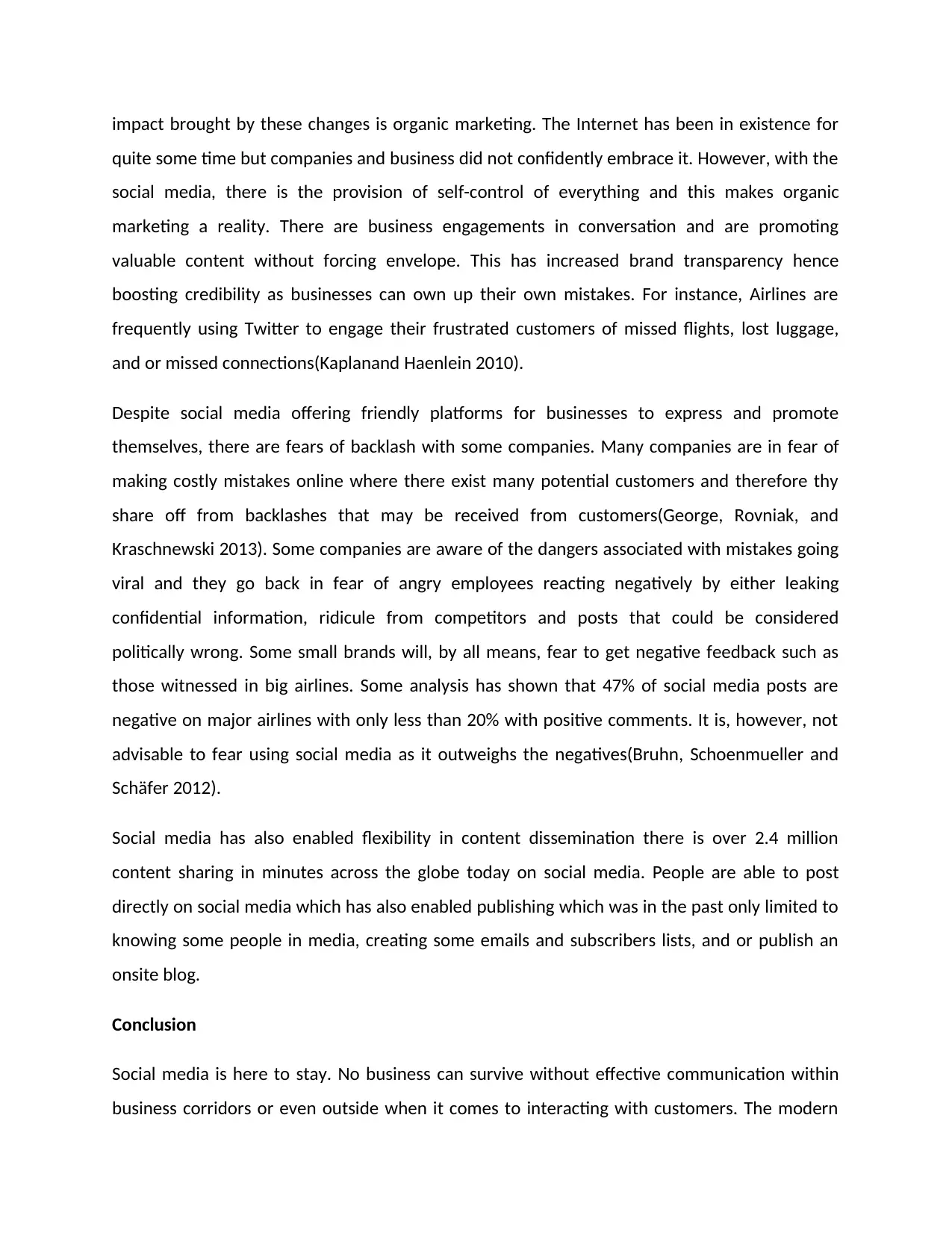
impact brought by these changes is organic marketing. The Internet has been in existence for
quite some time but companies and business did not confidently embrace it. However, with the
social media, there is the provision of self-control of everything and this makes organic
marketing a reality. There are business engagements in conversation and are promoting
valuable content without forcing envelope. This has increased brand transparency hence
boosting credibility as businesses can own up their own mistakes. For instance, Airlines are
frequently using Twitter to engage their frustrated customers of missed flights, lost luggage,
and or missed connections(Kaplanand Haenlein 2010).
Despite social media offering friendly platforms for businesses to express and promote
themselves, there are fears of backlash with some companies. Many companies are in fear of
making costly mistakes online where there exist many potential customers and therefore thy
share off from backlashes that may be received from customers(George, Rovniak, and
Kraschnewski 2013). Some companies are aware of the dangers associated with mistakes going
viral and they go back in fear of angry employees reacting negatively by either leaking
confidential information, ridicule from competitors and posts that could be considered
politically wrong. Some small brands will, by all means, fear to get negative feedback such as
those witnessed in big airlines. Some analysis has shown that 47% of social media posts are
negative on major airlines with only less than 20% with positive comments. It is, however, not
advisable to fear using social media as it outweighs the negatives(Bruhn, Schoenmueller and
Schäfer 2012).
Social media has also enabled flexibility in content dissemination there is over 2.4 million
content sharing in minutes across the globe today on social media. People are able to post
directly on social media which has also enabled publishing which was in the past only limited to
knowing some people in media, creating some emails and subscribers lists, and or publish an
onsite blog.
Conclusion
Social media is here to stay. No business can survive without effective communication within
business corridors or even outside when it comes to interacting with customers. The modern
quite some time but companies and business did not confidently embrace it. However, with the
social media, there is the provision of self-control of everything and this makes organic
marketing a reality. There are business engagements in conversation and are promoting
valuable content without forcing envelope. This has increased brand transparency hence
boosting credibility as businesses can own up their own mistakes. For instance, Airlines are
frequently using Twitter to engage their frustrated customers of missed flights, lost luggage,
and or missed connections(Kaplanand Haenlein 2010).
Despite social media offering friendly platforms for businesses to express and promote
themselves, there are fears of backlash with some companies. Many companies are in fear of
making costly mistakes online where there exist many potential customers and therefore thy
share off from backlashes that may be received from customers(George, Rovniak, and
Kraschnewski 2013). Some companies are aware of the dangers associated with mistakes going
viral and they go back in fear of angry employees reacting negatively by either leaking
confidential information, ridicule from competitors and posts that could be considered
politically wrong. Some small brands will, by all means, fear to get negative feedback such as
those witnessed in big airlines. Some analysis has shown that 47% of social media posts are
negative on major airlines with only less than 20% with positive comments. It is, however, not
advisable to fear using social media as it outweighs the negatives(Bruhn, Schoenmueller and
Schäfer 2012).
Social media has also enabled flexibility in content dissemination there is over 2.4 million
content sharing in minutes across the globe today on social media. People are able to post
directly on social media which has also enabled publishing which was in the past only limited to
knowing some people in media, creating some emails and subscribers lists, and or publish an
onsite blog.
Conclusion
Social media is here to stay. No business can survive without effective communication within
business corridors or even outside when it comes to interacting with customers. The modern
⊘ This is a preview!⊘
Do you want full access?
Subscribe today to unlock all pages.

Trusted by 1+ million students worldwide

business must be able to utilize the existence of social media in reaching potential customers
who are close to 11 million both on Facebook and Twitter just to mention a few. Facebook is
the giant social media, the most accessible and easy to use and this means many people are
using Facebook across the globe. However as business utilizes this great opportunity to win
themselves market shares, they must be consciously aware of the consequences that may arise
from mistakes made on the same. Employers should make their employees aware that their
postings have a direct impact on their business and therefore censor their posts before
releasing them to the public.
References
Aral, S., Dellarocas, C. and Godes, D., 2013. Introduction to the special issue—social media and
business transformation: a framework for research. Information Systems Research, 24(1), pp.3-
13.
Bruhn, M., Schoenmueller, V. and Schäfer, D.B., 2012. Are social media replacing traditional
media in terms of brand equity creation?.Management Research Review, 35(9), pp.770-790.
Cook, N., 2017. Enterprise 2.0: How social software will change the future of work. Routledge.
Culnan, M.J., McHugh, P.J., and Zubillaga, J.I., 2010. How large US companies can use Twitter
and other social media to gain business value. MIS Quarterly Executive, 9(4).
Edosomwan, S., Prakasan, S.K., Kouame, D., Watson, J. and Seymour, T., 2011.The history of
social media and its impact on business.Journal of Applied Management and Entrepreneurship,
16(3), p.79.
Erdoğmuş, İ.E., and Cicek, M., 2012.The impact of social media marketing on brand
loyalty.Procedia-Social and Behavioral Sciences, 58, pp.1353-1360.
who are close to 11 million both on Facebook and Twitter just to mention a few. Facebook is
the giant social media, the most accessible and easy to use and this means many people are
using Facebook across the globe. However as business utilizes this great opportunity to win
themselves market shares, they must be consciously aware of the consequences that may arise
from mistakes made on the same. Employers should make their employees aware that their
postings have a direct impact on their business and therefore censor their posts before
releasing them to the public.
References
Aral, S., Dellarocas, C. and Godes, D., 2013. Introduction to the special issue—social media and
business transformation: a framework for research. Information Systems Research, 24(1), pp.3-
13.
Bruhn, M., Schoenmueller, V. and Schäfer, D.B., 2012. Are social media replacing traditional
media in terms of brand equity creation?.Management Research Review, 35(9), pp.770-790.
Cook, N., 2017. Enterprise 2.0: How social software will change the future of work. Routledge.
Culnan, M.J., McHugh, P.J., and Zubillaga, J.I., 2010. How large US companies can use Twitter
and other social media to gain business value. MIS Quarterly Executive, 9(4).
Edosomwan, S., Prakasan, S.K., Kouame, D., Watson, J. and Seymour, T., 2011.The history of
social media and its impact on business.Journal of Applied Management and Entrepreneurship,
16(3), p.79.
Erdoğmuş, İ.E., and Cicek, M., 2012.The impact of social media marketing on brand
loyalty.Procedia-Social and Behavioral Sciences, 58, pp.1353-1360.
Paraphrase This Document
Need a fresh take? Get an instant paraphrase of this document with our AI Paraphraser
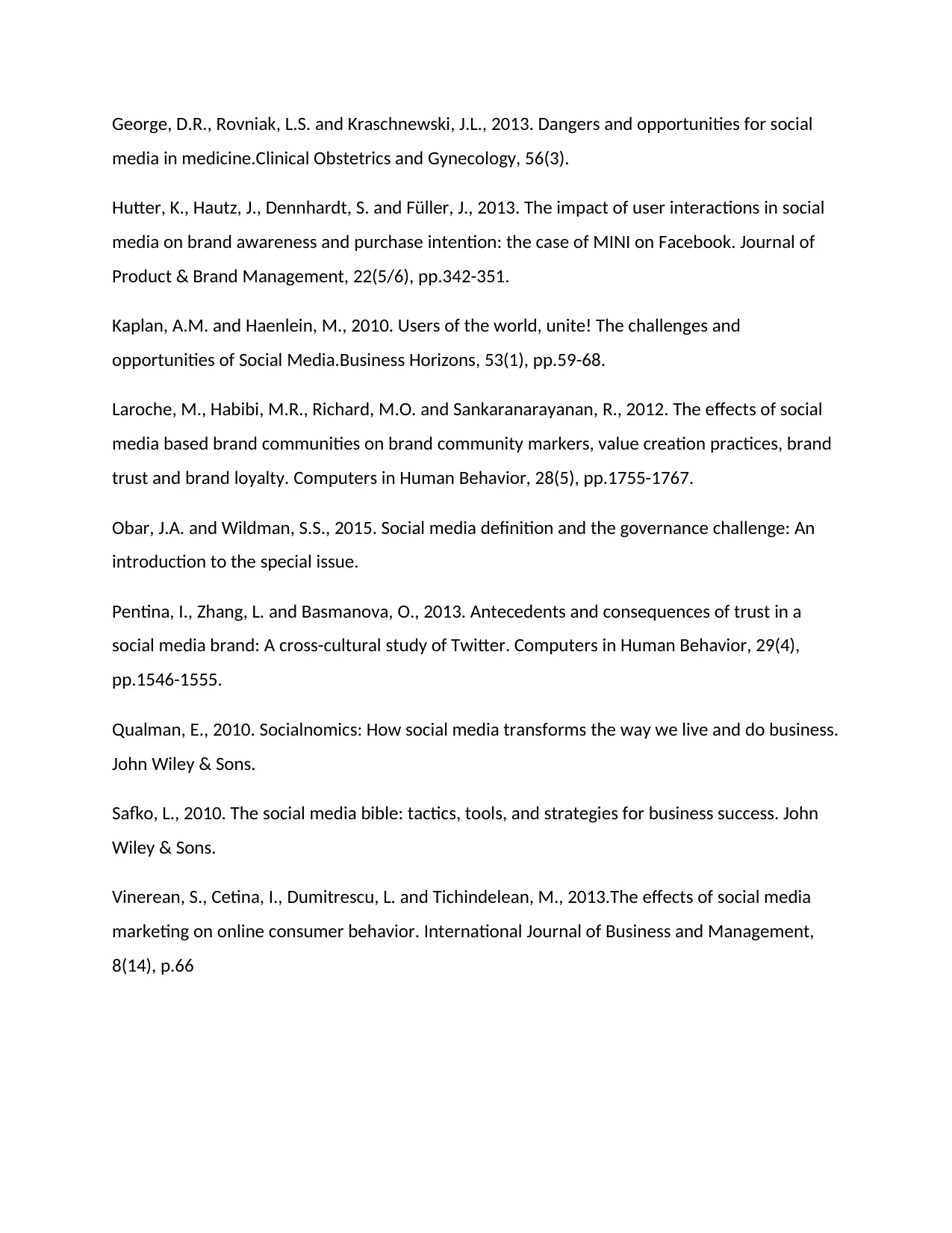
George, D.R., Rovniak, L.S. and Kraschnewski, J.L., 2013. Dangers and opportunities for social
media in medicine.Clinical Obstetrics and Gynecology, 56(3).
Hutter, K., Hautz, J., Dennhardt, S. and Füller, J., 2013. The impact of user interactions in social
media on brand awareness and purchase intention: the case of MINI on Facebook. Journal of
Product & Brand Management, 22(5/6), pp.342-351.
Kaplan, A.M. and Haenlein, M., 2010. Users of the world, unite! The challenges and
opportunities of Social Media.Business Horizons, 53(1), pp.59-68.
Laroche, M., Habibi, M.R., Richard, M.O. and Sankaranarayanan, R., 2012. The effects of social
media based brand communities on brand community markers, value creation practices, brand
trust and brand loyalty. Computers in Human Behavior, 28(5), pp.1755-1767.
Obar, J.A. and Wildman, S.S., 2015. Social media definition and the governance challenge: An
introduction to the special issue.
Pentina, I., Zhang, L. and Basmanova, O., 2013. Antecedents and consequences of trust in a
social media brand: A cross-cultural study of Twitter. Computers in Human Behavior, 29(4),
pp.1546-1555.
Qualman, E., 2010. Socialnomics: How social media transforms the way we live and do business.
John Wiley & Sons.
Safko, L., 2010. The social media bible: tactics, tools, and strategies for business success. John
Wiley & Sons.
Vinerean, S., Cetina, I., Dumitrescu, L. and Tichindelean, M., 2013.The effects of social media
marketing on online consumer behavior. International Journal of Business and Management,
8(14), p.66
media in medicine.Clinical Obstetrics and Gynecology, 56(3).
Hutter, K., Hautz, J., Dennhardt, S. and Füller, J., 2013. The impact of user interactions in social
media on brand awareness and purchase intention: the case of MINI on Facebook. Journal of
Product & Brand Management, 22(5/6), pp.342-351.
Kaplan, A.M. and Haenlein, M., 2010. Users of the world, unite! The challenges and
opportunities of Social Media.Business Horizons, 53(1), pp.59-68.
Laroche, M., Habibi, M.R., Richard, M.O. and Sankaranarayanan, R., 2012. The effects of social
media based brand communities on brand community markers, value creation practices, brand
trust and brand loyalty. Computers in Human Behavior, 28(5), pp.1755-1767.
Obar, J.A. and Wildman, S.S., 2015. Social media definition and the governance challenge: An
introduction to the special issue.
Pentina, I., Zhang, L. and Basmanova, O., 2013. Antecedents and consequences of trust in a
social media brand: A cross-cultural study of Twitter. Computers in Human Behavior, 29(4),
pp.1546-1555.
Qualman, E., 2010. Socialnomics: How social media transforms the way we live and do business.
John Wiley & Sons.
Safko, L., 2010. The social media bible: tactics, tools, and strategies for business success. John
Wiley & Sons.
Vinerean, S., Cetina, I., Dumitrescu, L. and Tichindelean, M., 2013.The effects of social media
marketing on online consumer behavior. International Journal of Business and Management,
8(14), p.66
1 out of 8
Related Documents
Your All-in-One AI-Powered Toolkit for Academic Success.
+13062052269
info@desklib.com
Available 24*7 on WhatsApp / Email
![[object Object]](/_next/static/media/star-bottom.7253800d.svg)
Unlock your academic potential
Copyright © 2020–2025 A2Z Services. All Rights Reserved. Developed and managed by ZUCOL.





